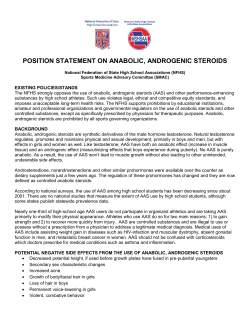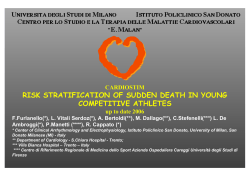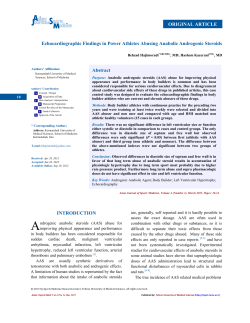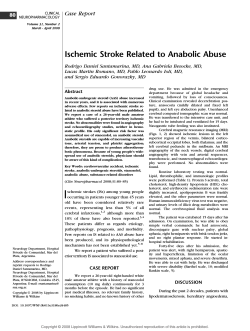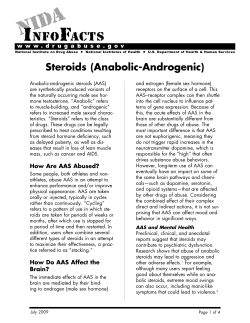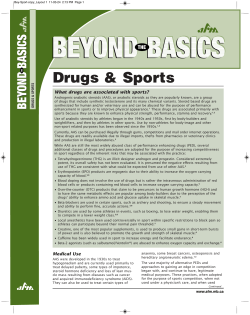
Document 6342
International Journal of Scientific and Research Publications, Volume 4, Issue 5, May 2014 ISSN 2250-3153 1 Hepatic Transaminase Activity in Nandrolone Decanoate treated Albino Mice Parmita Chowdhury and Dr. Rita Mahanta Department of Zoology, Cotton College, Guwahati (Assam), India Abstract- Anabolic-androgenic steroids (AAS) are the synthetic derivatives of testosterone which are widely accepted as performance enhancers and illicitly self-administered to increase muscle mass and physical endurance. The use of anabolic steroids by sportsmen and teenagers has increased to such extents thereby raising questions about their hepatotoxicity. The present study elucidates the adverse effects of AAS when administered at supraphysiological doses. Its focus is on the effects of massive doses of nandrolone decanoate, the most commonly abused AAS on the levels of the two important enzymatic liver biomarkers, aspartate aminotransferase (AST) and alanine aminotransferase (ALT) in albino mice. Tissue samples (liver tissue) were collected from normal control and nandrolone decanoate treated (2.5mg twice a week, administered intramuscularly for 13 weeks) albino mice and AST/ ALT levels of liver tissue were measured by following the method of Reitman and Frankel (1957).The results show a highly significant increase (p<0.01) in the AST and ALT levels in nandrolone decanoate treated albino mice compared to that of the normal control group. This study suggests that nandrolone decanoate abuse can cause liver toxicity which may alter the normal biochemical and pathological mechanism of the organism. Index Terms- Anabolic Androgenic Steroid, Nandrolone Decanoate, Liver tissue, Liver toxicity, ALT, AST I. INTRODUCTION A nabolic Androgenic Steroids (AAS) are synthetic compounds which are the derivatives of testosterone (Murad and Haynes, 1980). The androgenic effects of these hormones can be generally considered as those associated with masculinisation and the anabolic effects as those associated with protein building in skeletal muscle and bone (Kicman, 2008). Over 40 Anabolic Steroids are available worldwide in both oral and injectable forms (Hughes et al., 1995). Some of the most popular oral forms include methandrostenolone and methyltestosterone, while the most popular injectables include nandrolone and methenelone (Goldman et al., 1984). Androgens exert their effects in many parts of the body, including reproductive tissues, muscle, bone, hair follicles in the skin, the liver and kidneys and the haematopoietic, immune and central nervous systems (Mooradian et al., 1987). Conventionally, AAS have been used as a therapeutic agent in treating bone marrow failure, hypogonadal states, hereditary angioneurotic edema, renal disease and anaemia, and in the late stages of breast cancer (Wilson and Griffin, 1982), initiation of delayed puberty, and growth promotion (Basaria et al., 2001; Shahidi, 2001), but are now predominantly self-administered to enhance performance or body image (Kochakian and Yesalis, 2000; Llewellyn, 2007). Humans administer a myriad of AAS in complex regimes characterized by the concurrent and prolonged use of supraphysiological doses of multiple compounds that differ in their chemical properties and thus in their metabolic fate and signalling capacity (Clark et al., 2006; Llewellyn, 2007). These substances are frequently misused by athletes, bodybuilders and youths in order to increase muscle mass or enhance physical endurance (Kindlundh et al., 2001; Bahrke et al., 2004; Johnston et al., 2007; Kindlundh et al., 1998; Nilsson et al., 2001; Thiblin et al., 2005 and Sjoqvist, 2008), as well as by adolescents implicated in multiple illicit drug use outside of sports (Kindlundh et al., 1999; DuRant et al., 1993). Regimens of Anabolic Androgenic Steroid misuse have been reported involving doses ranging 10-100 times higher than therapeutic recommendations (Yesalis, 1995; Fudala, 2003; Parkinson, 2006; Wilson, 1988) when used to enhance lean body mass, the drugs are typically administered in cycles, ranging 4-20 weeks (Fudala, 2003; Parkinson, 2006). However, the desired effects of AAS are accompanied by numerous physical and psychological adverse effects (Evans, 2004; Hartgens, 2004); frequently acne, testicular atrophy and gynecomastia, less frequently cardiovascular effects such as hypertension, arrhythmia and myocardial infarction (Dickerman, 1997; Lenders, 1988), hepatic toxicity and jaundice, and in addition reproductive effects characterized by reduced libido, impotence, impaired spermatogenesis and prostate hypertrophy in men and hirsutism, voice deepening and menstrual irregularities in women (Evans, 2004; Hartgens, 2004). Furthermore, AAS misuse is associated with metabolic side effects such as insulin resistance, impaired glucose tolerance and altered lipoprotein profile (Evans, 2004; Maravelias, 2005). Anabolic androgenic steroids being marketed as dietary supplements are a cause for serious hepatotoxicity (Saukkonen et al., 2006; Kafrouni et al., 2007) resulting into symptoms that may include a jaundice or icterus appearance causing yellowing of the skin, eyes and mucous membranes, severe abdominal pain, nausea or vomiting, weakness, severe fatigue, continuous bleeding, skin rashes, generalized itching, swelling of the feet and legs, abnormal and rapid weight gain in a short period of time, dark urine and light coloured stool (Bleibel et al., 2007; Chang et al., 2007). There are evidences of liver injury being diagnosed by certain biochemical markers like alanine aminotransferase [ALT] and aspartate aminotransferase [AST], wherein it is proved that elevations in the serum enzyme levels like alanine aminotransferase [ALT] and aspartate aminotransferase [AST] are taken as the relevant indicators of liver toxicity (Singh et al., 2011). www.ijsrp.org International Journal of Scientific and Research Publications, Volume 4, Issue 5, May 2014 ISSN 2250-3153 Alanine aminotransferase (ALT) or serum glutamic pyruvic transaminase [SGPT] activity is the most frequently relied biomarker of hepatotoxicity that plays an important role in amino acid metabolism and gluconeogenesis. It catalyzes the reductive transfer of an amino group from alanine to α-ketoglutarate to yield glutamate and pyruvate. Elevated level of this enzyme is released during liver damage. The estimation of this enzyme is a more specific test for detecting liver abnormalities since it is primarily found in the liver (Dufour et al., 2000; Amacher, 2002). Aspartate aminotransferases (AST) or serum glutamic oxaloacetate transaminase [SGOT] is another liver enzyme that aids in producing proteins. It catalyzes the reductive transfer of an amino group from aspartate to α-ketoglutarate to yield oxaloacetate and glutamate. Besides liver, it is also found in other organs like heart, muscle, brain and kidney. Injury to any of these tissues can cause an elevated blood level (Nathwani et al., 2005). It also helps in detecting hepato-cellular necrosis but is considered a less specific biomarker enzyme for hepato-cellular injury (Ozer et al., 2008) as it can also signify abnormalities in heart, muscle, brain or kidney (Dufour et al., 2000). Therefore, the present study was planned with an aim to estimate the levels of two important enzymatic liver biomarkers, AST and ALT, upon administration of the most commonly abused AAS, Nandrolone Decanoate (ND) at doses much higher than the therapeutic recommendations. II. MATERIALS AND METHODS Animals Twenty healthy albino mice weighing approximately 25-30 grams were purchased from the Department of Zoology, Gauhati University. Before starting the experimental procedure, animals were acclimatized in the animal room for four weeks and fed on standard animal diet. Adequate measures were taken to minimize pain or discomfort to the mice and the experiments were conducted in accordance with International Standards on Animal Welfare as well as being compliant with local (Ethical Committee of Animal Welfare of Gauhati University, Guwahati, Assam, India) and national regulations. As per plan of the study the targeted number of animals was allocated into two groups: Group I (Normal control group): Ten (10) healthy albino mice without any sign of deficiencies were randomly selected for normal control group and maintained throughout the whole period of experiment in the same condition. Group II (Nandrolone Decanoate treated group): This group consisted of animals randomly selected from the general normally healthy pool of already acclimatized mice for the study. All animals of this group were injected with 2.5 mg (0.1 ml) nandrolone decanoate intramuscular, administered twice a week for a period of 90 days. The doses of ND administered to the animals and period of administration mimics one cycle of AAS abuse by athletes (Hall and Hall, 2005; Mirkhani et al., 2005; Trenton and Currier, 2005). 2 over a filter paper and immediately weighed and recorded. The tissue homogenate was prepared in deionised water with the help of tissue homogenizer. Tissues were collected from normal control as well as experimental mice on the desired days i.e. 15 th, 30th, 45th, 60th, 75th and 90th days. Liver tissues were collected from both the experimental groups of animals at an interval of 15 days upto the 90 th day for estimation of alanine aminotransferase and aspartate aminotransferase activities. Estimation of AST and ALT AST and ALT activities were estimated by the method of Reitman and Frankel (Reitman and Frankel, 1957) and the results are expressed in international units/litre. Statistical Analysis The results obtained are stated as mean ± Standard Error of the Mean (SEM). Statistical significance of differences among groups was analysed by one way analysis of variance. P<0.01 was considered statistically significant. III. RESULTS AND DISCUSSION Anabolic Androgenic Steroids are powerful pharmaceuticals resembling human androgens, primarily testosterone. They act as both anabolic and androgenic agents. Although these drugs have therapeutic roles, athletes and non-athletes often abuse AAS to improve their performance and physical endurance. When abused, AAS are known to cause negative health effects. It has already been reported that AAS abuse may induce liver toxicity such as jaundice, cholestasis and liver tumours (Sweeny and Evans, 1976; Haupt and Rovere, 1984). In the present investigation, with the experimental dosage of 0.1 ml of nandrolone decanoate administered twice a week, a highly significant increase (p < 0.01) in the two enzymatic liver biomarkers, AST and ALT was observed throughout the experimental period. The results of the enzyme estimations are set out in Table 1 (AST) and Table 3 (ALT). From the data laid down in the tables, it is evident that activities of the hepatic transaminases in the Nandrolone Decanoate treated group of animals are significantly higher than that of the untreated group of animals. The level of AST in the treated animals showed an increasing trend from the 15th day of treatment (0.0703 ± 0.002) to the 30th day (0.0802 ± 0.004) beyond which the enzyme activity gradually declined. Though the enzyme activity showed a gradual fall from the 45th day (0.0776 ± 0.006) to the 60th day of treatment (0.0640 ± 0.003), the level was again raised on the 75th (0.0648 ± 0.003) and 90th days (0.0663 ± 0.004) of treatment. AST level in the treated group of animals was seen to reach its peak on the 30th day (Fig. 1). Collection of Tissue Samples Mice anaesthetized by diethyl ether were dissected on the desired days to collect the liver tissues. The tissues were dried www.ijsrp.org International Journal of Scientific and Research Publications, Volume 4, Issue 5, May 2014 ISSN 2250-3153 3 Table1: Presenting the values of mean Aspartate Transaminase (AST) activity (unit/mg) in Liver Tissue of experimental groups at different days interval SD = Standard deviation , SEM= Standard Error of mean Normal group (n=10) Nandrolone Decanoate treated group (n=10) Days of treatment 45th day 60th day 15th day 30th day 75th day 90th day Mean 0.0519 0.0522 0.0516 0.0524 0.0523 0.0518 SD ± 0.005 0.005 0.003 0.005 0.005 0.003 SEM ± 0.001 0.001 0.001 0.002 0.002 0.001 Mean 0.0703 0.0802 0.0776 0.0640 0.0648 0.0663 SD ± 0.002 0.004 0.006 0.003 0.003 0.004 SEM ± 0.001 0.001 0.001 0.001 0.001 0.001 GROUPS Table2: Presenting significance of difference in the mean values of AST (unit/mg) in Liver tissue between different experimental groups at different days interval t = test of significance , p = level of significance , df = degree of freedom Groups Between Normal and Nandrolone Decanoate treated 15th day Days of treatment (CYP) 30th day 45th day 60th day 75th day 90th day t 9.2 15.45 12.85 6.45 6.9 7.2 p <0.01 <0.01 <0.01 <0.01 <0.01 <0.01 df 9 9 9 9 9 9 Figure1. Graphical representation of Aspartate Aminotransferase activity of experimental groups of animals at different days interval www.ijsrp.org International Journal of Scientific and Research Publications, Volume 4, Issue 5, May 2014 ISSN 2250-3153 4 Levels of ALT in the treated group of animals showed a gradual increasing trend from the 15 th day (0.0790 ± 0.002) up to the 45th day (0.110 ± 0.006) beyond which the enzyme activity gradually declined. The enzyme (ALT) activity in the treated group of animals reached its peak on the 45th day (Fig.2). Though the enzyme activity showed a gradual fall from the 60 th day (0.0840 ± 0.003) to the 90th day (0.0763 ± 0.004), their values were still higher than those of the untreated group of animals. Table3: Presenting the values of mean Alanine Transaminase (ALT) (unit/mg) in Liver Tissue of different experimental groups at different days interval Groups Between Normal and Nandrolone Decanoate treated 15th day Days of treatment (CYP) 30th day 45th day 60th day 75th day 90th day t 9.2 12.45 15.85 8.45 6.9 7.2 p <0.01 <0.01 <0.01 <0.01 <0.01 <0.01 df 9 9 9 9 9 9 Table4:Presenting significance of difference in the mean values of Alanine Transferase activity (unit/mg) in Liver tissue Between different experimental groups at different days interval Normal group (n=10) Nandrolone Decanoate treated group (n=10) Days of treatment 45th day 60th day 15th day 30th day 75th day 90th day Mean 0.0719 0.0722 0.0716 0.0724 0.0723 0.0718 SD ± 0.005 0.005 0.003 0.005 0.005 0.003 SEM ± 0.001 0.001 0.001 0.002 0.002 0.001 Mean 0.0790 0.0902 0.110 0.0840 0.079 0.0763 SD ± 0.002 0.004 0.006 0.003 0.003 0.004 SEM ± 0.001 0.001 0.001 0.001 0.001 0.001 GROUPS www.ijsrp.org International Journal of Scientific and Research Publications, Volume 4, Issue 5, May 2014 ISSN 2250-3153 5 Figure2: Graphical representation of Alanine Aminotransferase activity of experimental groups of animals at different days interval In case of both AST and ALT, the increase in the enzyme levels was found to be highly significant (p < 0.01) from the 30 th day to the 45th day of treatment while the decline in the enzyme levels was sustained upto the terminal phase of the study, i.e., upto the 90th day of treatment. Therefore, the study reveals a highly significant (p <0.01) elevation in the levels of AST and ALT in the nandrolone decanoate treated animals with peak values during the intermediate part covering 30th to 45th days. Thus our present investigation reveals that the activities of hepatic transaminases in the treated group of animals were raised to a level much higher than in the untreated ones. In the present investigation the statistically significant (P<0.01) rise in the hepatic transaminase activities of the Nandrolone Decanoate treated group may be attributed to severe causes of hepatotoxicity that may have probably arisen due to drug abuse. There are reports suggesting hepatic disorders and other liver related diseases in patients who had previously followed a regimen of chronic drug overuse. Thus our present study is in compliance with earlier reports on liver toxicity and drug metabolism. While still maintaining a higher than normal value, the decrease in the enzyme levels in the terminal phase of study may be attributed to the increased pathophysical condition of liver tissues as contributed by higher doses of nandrolone decanoate. The findings of the present investigation are in accordance with previous reports and agree well with the fact that steroid subjects demonstrated AST and ALT levels greater than normal. This paper thus presents an approach for identifying drug induced liver toxicity from the liver toxicity biomarker study. REFERENCES [1] [2] [3] [4] [5] [6] [7] [8] [9] [10] [11] [12] [13] [14] Amacher, D.E. A toxicologist’s guide to biomarkers of hepatic response. Hum Exp Toxicol, 2002; 21: 253-262. Bahrke, M.S., Yesalis, C.E. Abuse of anabolic androgenic steroids and related substances in sport and exercise. Curr. Opin. Pharmacol. 2004; 4:614-20. Basaria, S., Wahlstrom, J.T., Dobs, A.S. Clinical review 138: Anabolicandrogenic steroid therapy in the treatment of chronic diseases. J Clin Endocrinol Metab, 2001;86:5108–5117. [PubMed: 11701661]. Bleibel. W., Kim. S., D’Silva, K., Lemmer, E.R. Drug-induced liver injury: Review Article. Dig Dis Sci, 2007; 52: 2463-2471. Chang, C.Y., Schaino, T.D. Review article: Drug hepatotoxicity. Aliment Pharmacol Ther, 2007; 25: 1135-1151 Dickerman, R.D., McConathy, W.J., Zachariah, N.Y. Testosterone, sex hormone-binding globulin, lipoproteins and vascular disease risk. J Cardiovasc Risk, 1997; 4: 363-6. Dufour, D.R., Lott, J.A., Nolte, F.S., Gretch, D.R., Koff, R.S., et al. Diagnosis and monitoring of hepatic injury: I. Performance characteristics of laboratory tests. Clin Chem, 2000; 46: 2027-2049. DuRant, R.H., Rickert, V.I., Ashworth, C.S., Newman, C., Slavens, G. Use of multiple drugs among adolescents who use anabolic steroids. N Engl J Med, 1993; 328:922-6. Evans, N.A. Current concepts in anabolic androgenic steroids. Am J Sports Med, 2004; 32: 534-42. Fudala, P.J., Weinrieb, R.M., Calarco, J.S., Kampman, K.M., Boardman, C. An evaluation of anabolic androgenic steroid abusers over a period of one year: seven case studies. Ann Clin Psychiatry, 2003; 15: 121-30. Goldman, B., Klatz, R. and Bush, P. List of commonly used anabolic steroids with chemical structures and normal dosages. In Death in the Locker Room (ed. Goldman, B.). Appendix 24, 1984; pp. 299-301. Icarus Press, South Bend, IN. Hall, R.C. and Hall, R.C. Abuse of supraphysiologic doses of anabolic steroids. South Med J, 2005; 98:550-555. Hartgens, F., Kuipers, H. Effects of androgenic anabolic steroids in athletes. Sports Med (Auckland, NZ) 2004; 34:513-54. Haupt, H. and Rovere, G. Anabolic steroids: a review of the literature. Am J Sports Med, 1984; 12: 469-484. www.ijsrp.org International Journal of Scientific and Research Publications, Volume 4, Issue 5, May 2014 ISSN 2250-3153 [15] Hughes, T.K., Fulep, E., Juelich, T., Smith, E.M. and Stanton, G.J. Modulation of immune responses by anabolic androgenic steroids. J. Immunopharmac, 1995; Vol 17. No. 11, pp. 857-863. [16] Johnston, L.D., O’Malley, P.M., Bachman, J.G., Schulenberg, J.E. Monitoring the future national results on adolescent drug use: overview of key findings, 2007 (NIH Publication No.08-6418). National Institute on Drug Abuse, Betheseda, MD, 2008. [17] Kafrouni, M.I., Anders, R.A., Verma, S. Hepatotoxicity associated with dietary supplements containing anabolic steroids. Clinical Gastroenterol Hepatol, 2007; 5: 809-812. [18] Kicman, A.T. Pharmacology of anabolic steroids. Br. J. Pharmacol, June 2008; 154(3):502-521. [19] Kindlundh, A.M., Isacson, D.G., Berglund, L., Nyberg, F. Doping among high school students in Uppsala, Sweden: a presentation of the attitudes, distribution, side effects and extent of use. Scand. J. Soc. Med. 1998; 26:714. [20] Kindlundh, A.M., Isacson, D.G., Berglund, L., Nyberg, F. Factors associated with adolescent use of doping agents: anabolic–androgenic steroids. Addiction (Abingdon, England) 1999; 94: 543-53. [21] Kindlundh, A.M., Hagekull, B., Isacson, D.G., Nyberg, F. Adolescent use of anabolic androgenic steroids and relations to self reports of social, personality and health aspects. Eur. J. Public Health. 2001;11:322-8. [22] Kochakian, C., Yesalis, C.E. Anabolic-androgenic steroids: a historical perspective and definition. In: Yesalis, C.E., editor. Anabolic Steroids in Sport and Exercise. Champaign: Human Kinetics, 2000; p. 4-33. [23] Lenders, J.W., Demacker, P.N., Vos, J.A. et al. Deleterious effects of anabolic steroids on serum lipoproteins, blood pressure and liver function in amateur body builders. Int J Sports Med.1988; 9:19-23. [24] Llewellyn, W. Anabolics. Vol. 6th Edition. Jupiter FL: Body of Science; 2007. [25] Maravelias, C., Dona, A., Stefanidou, M., Spiliopoulou, C. Adverse effects of anabolic steroids in athletes. A constant threat. Toxicol Lett 2005; 158: 167-75. [26] Mirkhani, H., Golbahar, J. and Shokri, S. Chronic administration of nandrolone decanoate does not increase the plasma homocystein level of male rats. Basic Clin Pharmacol Toxicol. 2005; 97:214-217. [27] Mooradian, A.D., Morley, J.E., Korenman, S.G. Biological actions of androgens. Endocr Rev. 1987; 8:1-28 [Pubmed]. [28] Murad, F. and Haynes, R.C., Jr. Androgens and anabolic steroids. In The Pharmacological Basis of Therapeutics,1980; (eds Gilman, A.G., Goodman, L.S. and Gilman, A.), 6th edn. Macmillan, New York. [29] Nathwani, R.A., Pais, S., Reynolds, T.B., Kaplowitz, N. Serum alanine aminotransferase in skeletal muscle diseases. Hepatology, 2005; 41: 380382. [30] Nilsson, S., Baigi, A., Marklund, B., Fridlund, B. The prevalence of the use of androgenic anabolic steroids by adolescents in a county of Sweden. Eur. J. Public Health. 2001; 11:195-7. 6 [31] Ozer, J., Ratner, M., Shaw, M., Bailey, W., Schomaker, S., et al. The current state of serum biomarkers of hepatotoxicity. Toxicology, 2008; 245: 194-205. [32] Parkinson, A.B., Evans, N.A. Anabolic androgenic steroids: a survey of 500 users. Med Sci Sports Exerc 2006; 38:644-51. [33] Reitman, S., and Frankel, S. Amer. J. clin. Path., 1957; 28, 56. [34] Saukkonen, J.J., Cohn, D.L., Jasmer, R.M., Schenker, S., Jereb, J.A., et al. An Official ATS Statement: Hepatotoxicity of antituberculosis therapy. Am J Respir Crit Care Med, 2006; 174: 935-952. [35] Shahidi, N.T. A review of the chemistry, biological action, and clinical applications of anabolic-androgenic steroids. Clin Ther, 2001; 23:1355– 1390. [PubMed: 11589254]. [36] Singh, A., Bhat, T.K. and Sharma, O.P. Clinical biochemistry of hepatotoxicity. J Clinic Toxicol, 2011, S4:001. doi:10.4172/2161-0495.S4001 [37] Sjoqvist, F., Garle, M., Rane, A. Use of doping agents, particularly anabolic steroids, in sports and society. Lancet. 2008; 371:1872-82. [38] Sweeny, E. and Evans, D. Hepatic lesions in patients treated with synthetic anabolic steroids. J Clin Pathol, 1976; 29: 626-633. [39] Thiblin, I., Petersson, A. Pharmacoepidemiology of anabolic androgenic steroids: a review. Fundam Clin Pharmacol. 2005; 19:27-44. [40] Trenton, A.J. and Currier, G.W. Behavioural manifestations of anabolic steroid use. CNS Drugs. 2005; 19: 571-595. [41] Wilson, J.D. Androgen abuse by athletes. Endocr Rev. 1988; 9:181-99. [42] Wilson, J.D. and Griffin, J.E. The use and misuse of androgens. Metabolism. 1982; 29, 1278-1295. [43] Yesalis, C.E., Bahrke, M.S. Anabolic androgenic steroids. Current issues. Sports Med (Auckland, NZ), 1995; 19:326-40. AUTHORS First Author – Parmita Chowdhury, Research Fellow (Ph.D.), Department of Zoology, Gauhati University, Guwahati, Assam, PIN- 781014, E-mail: parmitachoudhury@rediffmail.com Second Author – Dr. Rita Mahanta , Associate Professor (retd.) Department of Zoology, Cotton College, Guwahati, Assam, PIN781001, E-mail: ritamahanta@yahoo.co.in Correspondence Author – Parmita Chowdhury, Research Fellow (Ph.D.), Department of Zoology, Gauhati University, Guwahati, Assam, PIN- 781014, E-mail: parmitachoudhury@rediffmail.com, parmitachowdhury13@gmail.com, Phone no. +91 9864075410 www.ijsrp.org
© Copyright 2025

